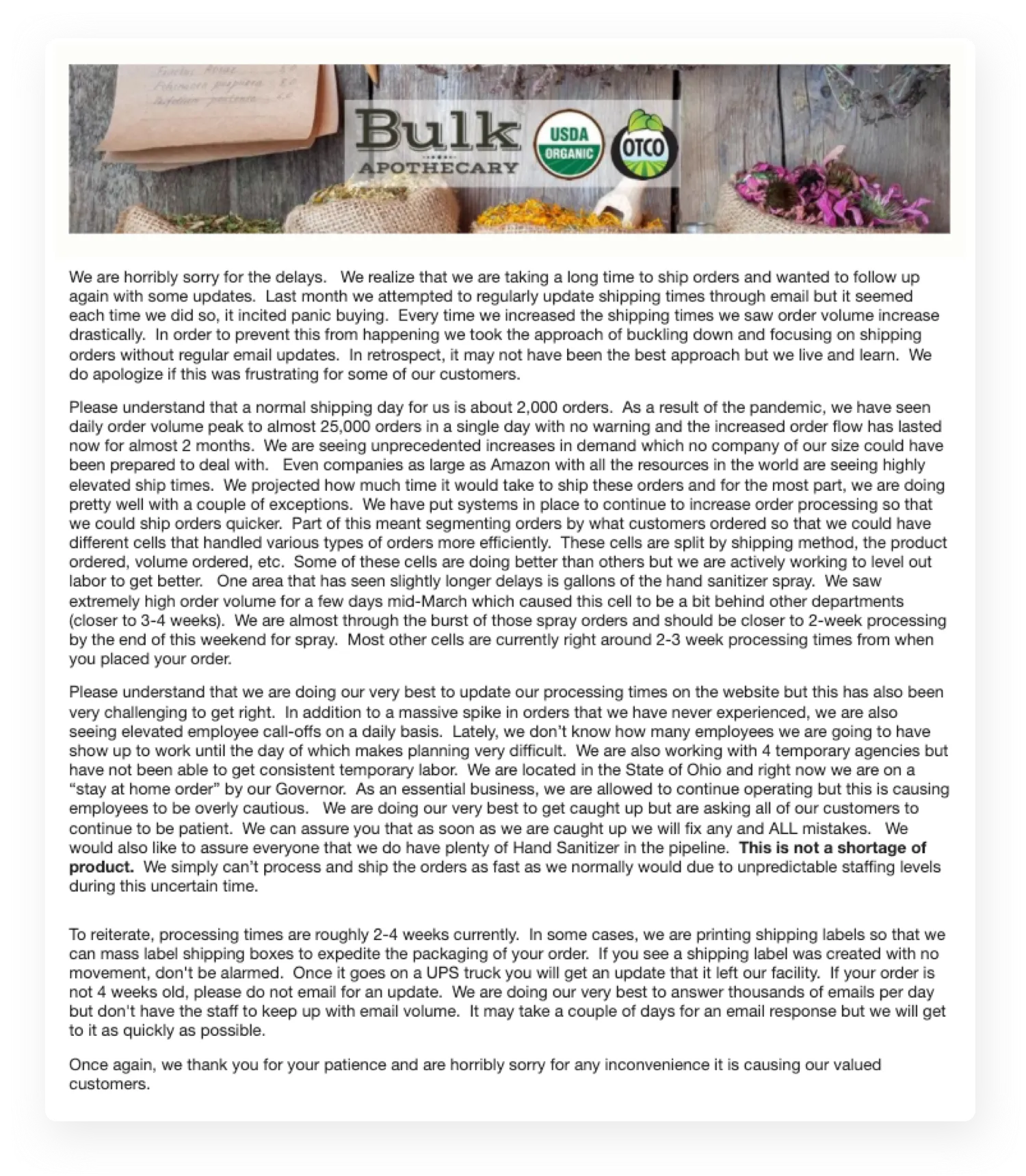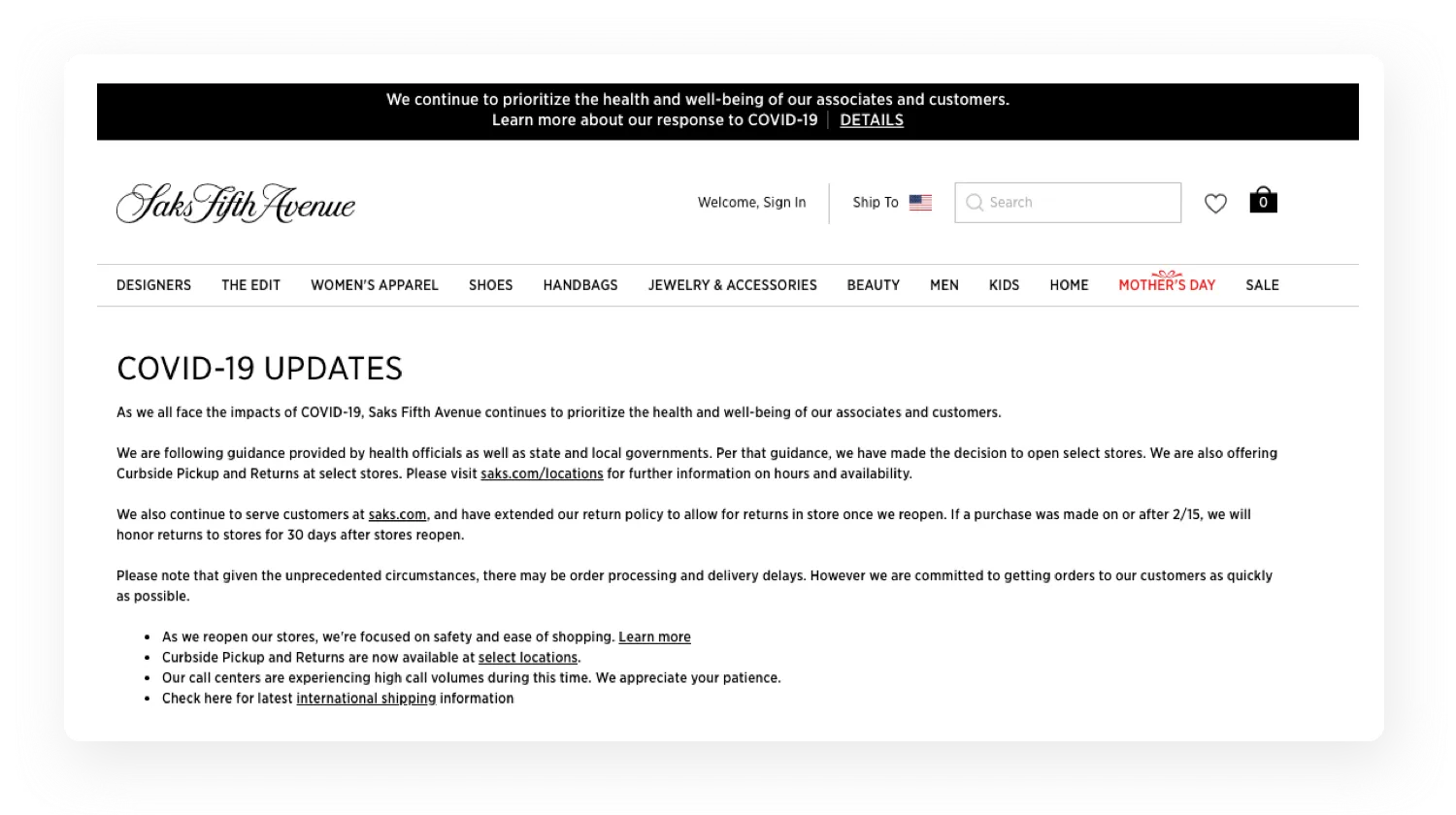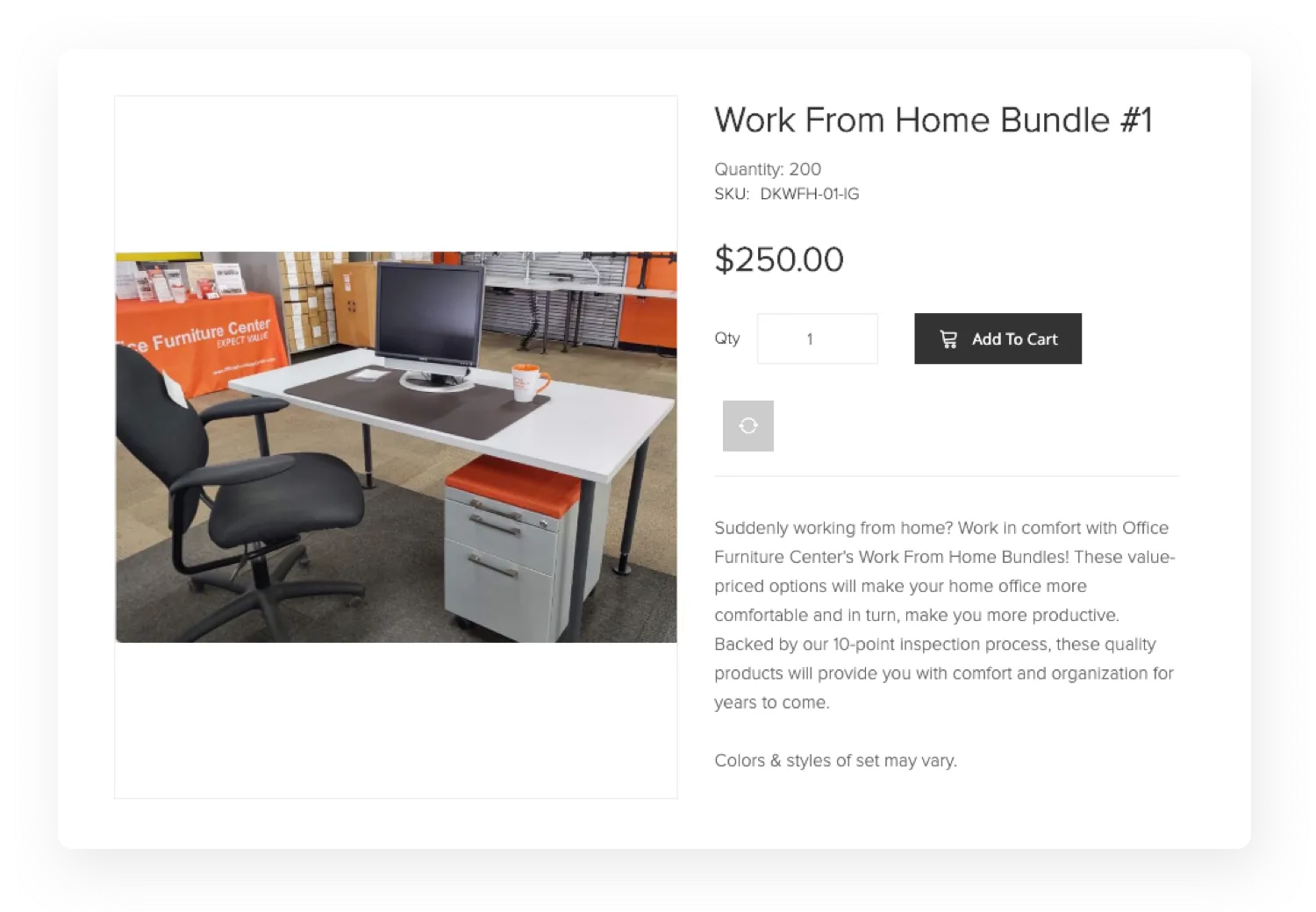May 14, 2020
How to talk to your ecommerce customers about delayed fulfillment
With more consumers at home to prevent the spread of the novel coronavirus, retailers have seen massive jumps in online order volumes, leading to delays in order processing, shipping, and restocking inventory. Here are 12 actionable tips from leading brands that are managing to keep customers engaged and satisfied during disruption.

In the wake of the COVID-19 crisis, ecommerce activity has soared, with the number of unique digital shoppers up by 40 percent year-over-year (YoY) and some categories such as groceries, home goods, and items related to health and safety up by 100 to nearly 700 percent YoY.
With the recent surge in online orders, keeping inventory stocked and the staff on hand to manage fulfillment has been a challenge for many brands. On top of that, postal workers are inundated with packages to send, leading to shipping delays that are sometimes out of your control. As a result, fulfillment time has increased by almost 40 percent for some retailers.
Although these challenges may seem chaotic and overwhelming, there are concrete steps you can take to mitigate the negative impact of these disruptions and keep customers engaged and satisfied. This blog will provide actionable tips and examples for managing COVID-related supply chain disruptions, including:
- How to maintain transparency with customers, even when exact circumstances are uncertain or rapidly evolving
- How to manage limited inventory and streamline fulfillment processes
- How to continue encouraging sales of delayed or sold-out items
- How to engage and delight customers while they’re waiting for their orders to be delivered
… and more!
12 Tips for Managing Supply Chain Disruptions Caused by COVID-19
1. Apologise when things get out of hand.
Apologizing is a good practice for both life and business.
Little could have prepared the retail industry for the sudden and widespread disruptions caused by the COVID-19 pandemic, and its supply chain impacts aren’t necessarily anyone’s fault. Acknowledging these challenges and their effects on the customer experience is a very natural and human thing to do, and it’ll go a long way toward maintaining your brand’s customer relationships.
For example, natural ingredient supplier Bulk Apothecary recently sent out this email regarding shipping and order fulfillment:

This email sets a great example for the rest of the ecommerce world. It’s extremely transparent about delays and expectations regarding order fulfillment, apologetic about the areas that went wrong, and as straightforward as possible about important information that customers should know.
Because panic-buying is so widespread right now, honesty and transparency are critical. Customers may not always be happy with the time it’s taking to fulfill their orders, but if you’re upfront about the challenges you’re facing and as clear as possible about what they can and cannot expect from your brand, then they’ll meet you with patience and respect.
2. Display a prominent message on your website addressing any issues.
If you know you’re having supply chain issues, you need to address them as soon as possible before customers place their orders to avoid misunderstandings. Simply providing customers with all of the information regarding shipment before they place their order can help you manage expectations and increase customer satisfaction.
You may want to display these messages at different places during the customer journey, depending on the types and severity of supply chain issues you’re having.
For example, you could display the message on the top of your homepage as soon as customers land on your website like Saks Fifth Avenue has done:

Or, like Adore Beauty, you could wait until customers hit the checkout page to notify customers of potential shipping delays:

If the delays are only affecting certain products or categories, you could also choose to flag only these products in the browsing pages, so they don’t impact the shopping experience for other items.
Try to put yourself in the customers’ shoes. They may have different responses for different types of supply chain issues, so consider when and how to present these messages to maximize customer satisfaction and conversions.
3. If you aren’t experiencing delays, tell your customers that too!
Some retailers aren’t experiencing any known shipping or order fulfillment delays, but these issues are so widespread that customers may be hesitant to place a final order on your website.
If you’re one of the lucky brands that haven’t been drastically affected, make sure your customers know that too. For example, women’s loungewear brand Negative Underwear has a simple message on their homepage stating that they’re open for business and offering free shipping in the United States on orders greater than $75.

4. Encourage customers to limit bulk purchases of certain items.
The pandemic has caused widespread panic-buying, particularly of household goods and consumables. If you’re looking to manage inventory levels to ensure as many customers as possible are able to order what they need, consider setting limits on bulk purchases.
For example, the supermarket chain Woolworths set a limit of two-packs of flour per customer when stock was running low due to COVID-related panic-buying.
By setting limits on the number of items individual customers can purchase, you can pace the output of inventory and prevent a small number of customers from hoarding items from the rest of your customer base. This strategy ensures that more customers get their needs met and boosts trust and confidence in your brand.
5. On the other hand, consider creating bundles of common products that customers are stockpiling to increase order value and streamline fulfillment.
If you know that certain product categories and combinations have become more popular due to the COVID-19 pandemic, consider bundling those products to streamline both the shopping experience and the fulfillment process for those orders.
For example, many consumers are working from home for the first time due to social distancing orders, and they need to stock up on home office supplies to maintain their productivity. As a response to this need, Office Furniture Center created a few different Work From Home bundles that include desks, chairs, and cabinets.

Bundles like these encourage higher-value orders from customers who would’ve otherwise only purchased one or two of the items, and they make the shopping experience easier and more efficient. Many customers will be pleased to avoid the added mental energy of mixing-and-matching these items on their own during an already-stressful period, and your staff can fulfill these orders more quickly by having the bundled items set aside and ready to ship together.
6. Offer incentives to continue capturing sales of sold-out products.
Just because an item is sold out doesn’t mean you can’t continue to capture sales of that item. In fact, customers who were searching for that product specifically will often be assuaged by the ability to place their order ahead of time to ensure they’re first in line when more inventory is ready to ship.
Offering pre-order incentives, such as the 15% discount Uncharted Supply Co. is offering for its Seventy2 and Seventy2 Pro survival packs, encourages customers to convert on a sold-out item while still mitigating any disappointment or dissatisfaction they might feel about having to wait.

7. Prioritise fulfillment of orders by your most loyal customers to preserve the relationship.
Loyal customers who make multiple purchases over the course of their customer lifetimes will undoubtedly add more value to your business than one-time customers will. If your supply chain disruptions are extreme, you may want to consider pushing orders placed by these high-value customers to the front of the queue to strengthen and maintain that relationship for the future.
For example, toilet paper supplier Who Gives A Crap is prioritizing returning customers and those who’ve signed up for their waitlist. Although this strategy forces some customers to wait, their supply chain disruptions are so impactful due to the skyrocketing demand for toilet paper that it would be next to impossible to satisfy all of their customers at once.
8. Update automated order confirmation messages, shipping confirmation messages, and shipping updates to remind customers about the status of their orders.
Many brands with an ecommerce presence already have automated messages set up to update customers on the status of their orders as they move through the fulfillment and shipping process. If you’re experiencing delays or disruptions, these messages are a great place to remind your customers of these delays and alert them to any other important information.
For example, beauty brand Ulta has started sending out this email with the subject line, “Important update about your Ulta Beauty order—longer processing times:”

Including this quick message in their post-purchase workflow helps manage customer expectations, offers more information to give customers a feeling of control and confidence over their order, and strengthens customer relationships by thanking them for their understanding and loyalty.
9. Engage customers online while they’re waiting for their deliveries.
Customers will be the most engaged and excited about your brand immediately following their purchase. Maintain that momentum by providing them with content, events, sweepstakes, and other virtual engagement activities to keep your brand top-of-mind while they’re waiting for their delivery.
By offering continued engagement opportunities on your website, your social media platforms, and other digital channels, you can maintain an entertaining and satisfactory relationship with your customers. Even if they have to wait longer than usual for their deliveries, this engagement will help strengthen their emotional connection to your brand.
For ideas and inspiration on content creation, check out this blog post with 11 real-life examples.
10. If you haven’t yet, set up an automated email confirming when packages have been delivered.
A delivery notification is another great message to add to your post-purchase workflow, if you don’t already have one set up. By notifying customers when their packages have been delivered, you can ensure they pick up the package as soon as possible, express your gratitude for their support, ask for or offer any more relevant information, and direct them to other conversion opportunities.
For example, Old Navy sent this email to notify me when my package was delivered to my doorstep:

The email included an overview of my order receipt, confirmation that it was delivered to the correct address, and a link to the customer service page in the event that I couldn’t find my package.
Depending on the customer you send this to and your goals for this message, you could also include some survey questions to gather more zero-party customer data or include a “recommended products” section to encourage their next purchase.
11. Create a post-purchase campaign following order delivery to nurture customer loyalty.
Post-purchase nurture campaigns have been a best practice for some time now, and they can still be effective in the era of COVID-19. Instead of forgetting about your customers once their order is delivered, continuing to engage with them with a tailored post-purchase campaign can boost the lifetime value they provide to your brand.
Using customer insights, you can develop personalized post-purchase campaigns that are targeted to high-value customer segments. The insights you glean from your existing customer data, as well as any third-party data you use to enrich your database, will indicate the best cadence, message, and channel for your post-purchase campaign, maximizing its effectiveness.
A Customer Data Platform can help you cultivate an optimal customer experience, even in times of crisis
The brands that provide the best possible digital experience to their customers are the ones who consider how to optimize every aspect of that experience, from the time a customer lands on their website to the moment their package is delivered.
Although the COVID-19 crisis is impacting every aspect of the supply chain, the good news is that the boost in ecommerce activity is providing brands with a wealth of new, valuable data that can help them better understand their customers and provide them with the experiences they deserve.
Managing that data on your own can be tough. As life and business begin to shift back to normal, consider investing in a CDP partner like Lexer to help you take control of your new data, achieve real-time customer insights as consumer behavior continues to evolve, and develop innovative strategies for engaging and converting your customers at every touchpoint.
Looking for more resources on how best to operate your business through the COVID-19 crisis? Click here to view our retail-focused tips, examples, and guides.
If you’re not sure where to start, Lexer is here to help. Book a chat with a co-founder.
Speak with our retail experts

